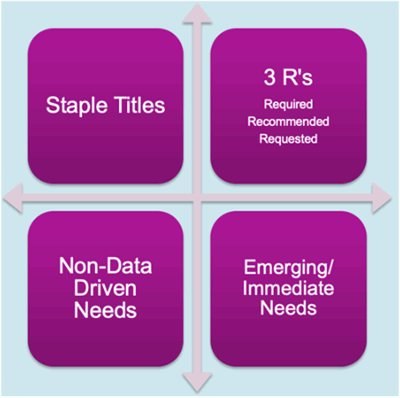
|
||
|
||
|
Editor’s Note: Based on “Stronger Together: Collaborating on Collection Development with Subject Niche Liaison Librarians”, a poster presented at the Medical Library Association (MLA) Annual Conference 2023, Detroit, MI. The Medical University of South Carolina (MUSC) is one of the few stand-alone academic health sciences campuses that is not affiliated with another institution. MUSC educates more than 3,200 students across six colleges, along with training over 900 residents and fellows within the health system. With so many different needs, the Libraries’ Director of Information Resources and Collection Services (DIRCS) relies on collaborating with liaison librarians for resource and collection development. Building the collections requires a balance of retaining material, sustaining current needs, and containing costs while providing justification for the expenditures. Librarians tasked with collecting for a specific subject will need to determine if the current collection has the foundational material necessary to meet certain standards. Within health sciences, these standards range between the academic and clinical benchmarks, depending on the organization’s strategic mission. Using a comparative analysis can help show the gaps between the current collection and those standards, but knowing or defining the standards to conduct that comparison can be tricky. In 2017, DIRCS began to work with the College of Pharmacy liaison on a new collection development strategy. This required the creation of a core collection for pharmacy. Generally, a core collection is the retention of specified resources that often requires a justification for continued costs. These are the resources necessary for supporting the organization’s needs and standards. Traditionally, these resources consisted of specific book and journal titles, such as Harrison’s Principles of Internal Medicine or the Journal of the American Medical Association (JAMA), and libraries were expected to have or obtain access to them. But over time, these titles evolved into something more, and now there isn’t one resource identified as being a quintessential title among collections. Creating an individualized core collection will define the needed standards and help shape future development. To help identify the Core Collection for Pharmacy (CCP), DIRCS created a simple binary classification grid and took the weighted intersection of four factors: A, B, C, and D. These factors will need to have defined attributes but consider any four traits that are instrumental to a library’s development. A. Staple Titles. These are “classic reference” titles, and depending on the organization, may range from clinically oriented material like Harrison’s Principles of Internal Medicine to more academic titles like Bates’ Guide to Physical Examination and History Taking. B. 3 R’s is abbreviated for the Recommendations, Requests, and Required materials. To demonstrate the range of what this entails, an academic institution will focus on textbooks and test preparations while a hospital setting may receive more current literature recommendations or requests. It is entirely realistic that both instances are applicable to an organization. C. Non-Data Driven Needs are the “supposed-to-haves” that are motivated by the organization’s values and mission. D. Emerging/Immediate Needs can be hard to justify, but typically current climate and trends allow some flexibility for development.
Figure 1: Binary Classification Collection Development Grid
To identify the CCP, DIRCS used this grid to help justify the acquisitions for books and some journals. In 2017, the collection analysis identified only 21% of the 3 R’s as being subscribed or owned; specifically, this was a combination of recommended titles via Doody’s Core Titles and known required textbooks. Working with the subject liaison, the 2022 analysis showed a 47% increase to required and requested material. It took several years before DIRCS was able to use similar methods to apply to the College of Dental Medicine collection. Specifically, this collaboration allowed DIRCS to identify and acquire much needed and sought after core resources relevant to dental medicine. In addition to core books and journals, the long-requested head and neck modules from AnatomyTV were purchased.
This project highlighted the importance of proactive communication between DIRCS and liaison librarians. This open channel of communication has provided liaisons with enhanced understanding of licensing challenges and opportunities for learning. Liaisons have been able to inform faculty of institutional availability, such as limited access vs unlimited, when selecting texts. Additionally, a communications coordinator was hired for the IRCS team to provide customized information sessions and product demonstrations based on the needs of the liaison librarians. The coordinator provides a point of contact for all things resource related, keeping everyone up to date on upcoming vendor training opportunities and new platform updates. Unexpected outcomes from the project included the creation of a “Recommend a Purchase” form to streamline purchase requests, and the purchase request tracking spreadsheet was shared to reduce duplicate requests.
One of the most important takeaways of this project is that collaboration with dedicated subject liaisons has initially shown a better Cost per Use (CPU) for books and journals in the identified core collections. Utilizing a specific set of core resources from one vendor, DIRCS considered the relationship of the service and the costs of providing that service. By putting usage within the context of costs, the CPU metric essentially monetizes the value of library resources and demonstrates that not all usage is captured equally. Initial analysis of vendor metrics suggests better cost-savings with licensed resources negotiated by DIRCS. For example, one subset within the core collection for pharmacy, there was a 27% cost savings compared to subjects that DIRCS had not the opportunity to collaborate with the liaison librarians on. DIRCS is applying the Binary Classification Collection Development Grid to additional subjects to identify further liaison opportunities.
DCT Featured Article – June 11, 2024
|
||
| Copyright 2014 - Doody Enterprises, Inc. - All rights reserved |

